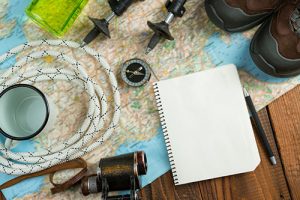PLATINUM
Hiking Safety – Plan Your Hike and Hike Your Plan
 Hiking can be a very rewarding distraction from the daily grind, but hiking safety should NEVER be taken for granted! Preparation for your hike ahead of time, and making sure you pack the essentials will give you peace of mind, and make your experience even more enjoyable.
Hiking can be a very rewarding distraction from the daily grind, but hiking safety should NEVER be taken for granted! Preparation for your hike ahead of time, and making sure you pack the essentials will give you peace of mind, and make your experience even more enjoyable.
Preparation
- Plan your hike.
You are more likely to have a safe and happy hike if you plan your hike, and hike your plan. To rush out on a big hike without proper planning is asking for trouble! ALWAYS notify someone close to you where you will be and how long you will be gone. An extra precaution would be to provide them with a map of your hiking location, especially if it will be a long or trecherous hike. - Know your terrain.
Use every resource available to get to know your hiking trail before you set out. This will prepare you for the walking conditions. “Are there streams to ford?, Elevation changes?, Is terrain rocky or smooth?”, Just some of the questions that should be answered BEFORE you set out.A great app for your mobile phone, that can help with knowing your trails and terrain, is AllTrails
- Know your climate.
Hypothermia is real, dangerous, and misunderstood. Hypothermia can strike in relatively warm environments. Hypothermia plain and simple is a rapid cooling of the body. This can be caused by cold, wet, or a combination of both. Hypothermia can easily be prevented with proper preparation.- Check with your doctor whether certain health problems you have or medicines you take can affect your body temperature. You may need to take extra steps to protect yourself from hypothermia.
- Wear as many layers of loose-fitting clothing as needed to stay warm. Keep your head and neck covered with a hat and scarf. Wear a coat or jacket that protects against the wind and rain. Also, protect your hands with gloves and your feet with socks and boots and try to stay dry.
- If clothing gets wet, go indoors and remove wet items as soon as possible.
- And be sure to get enough food and rest to help your body be ready to protect itself against cold.
In The Pack Essentials
- Potable water.
Always have fresh water available, on any excursion. You might also want to bring along purification tablets and/or a filtration device. Having the ability to produce drinking water can be just as important as the water you pack in. It’s also a good idea to bring along some protein snacks, just in case. - First Aid Kit.
Although an obvious choice, it is surprising how many folks go in the wilderness without one. Items as simple as pain relief tablets can be a welcome addition when you are far from civilization. Other items are bandages, tweezers, moleskin, antiseptic, needle and thread (for repairs). - Fire and light source.
Matches and a lighter are essentials. Also, pack along a small piece of commercial starter stick for quick fires in moist environments. Don’t forget a small conventional flashlight and an LED light, as well. - Clothing.
It is always wise to pack some extra layers. The weight of these items will be dictated by the environment, err to the side of caution, as temps can fluctuate greatly, especially in mountainous environments. An extra pair of socks can be life savers. - Orienteering.
Packing along a map and compass can really help you out of a jam. Carry a cell phone, even though you may not get reception in most places…in a pinch, you may be able to get a call out.
The single most important item to pack on your next hike is common sense. Making sound decisions while on the trail will keep you out of most troubled situations. If you hike with your family members, especially children or seniors, remember that they may not have the stamina to handle the same level hike as you, and you ultimately must make the right decision for everyone on the hike.





































